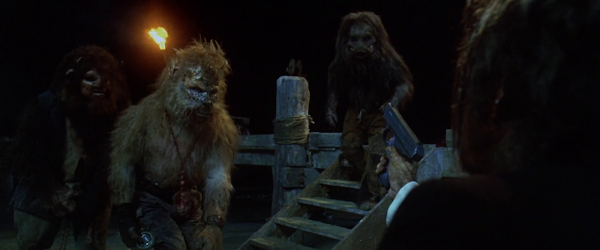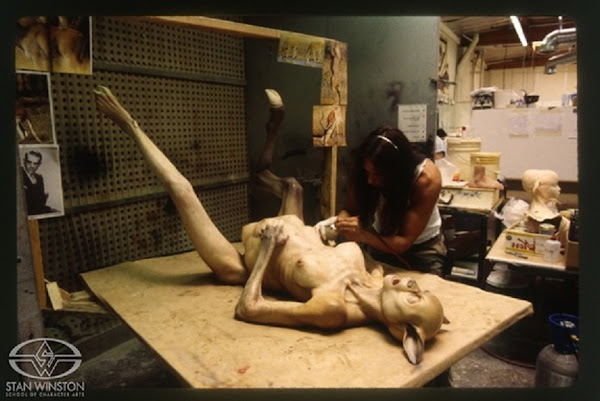The third film adaptation of H. G. Wells' novel had its beast-men realized by Stan Winston Studios primarily as prosthetic makeups, as Winston by this point of time was tired of having to utilize full puppetry; 'I wanted to create the man-beasts primarily as prosthetic makeups so that I could take the performance out of the puppeteer’s hands and put it back under the control of the performers in the makeups. This was the perfect project to do that because these characters were essentially humanoid.'
Among Winston's team of makeup artists were Shane Mahan (who was supervisor on the production), Ursula Ward, Alan Scott, Joey Orosco, Beth A. Hathaway, Mike Smithson, Bruce Spaulding Fuller and Mark 'Crash' McCreery. McCreery provided the concept artwork before of the Sayer of the Law, Lo-Mai, the Bison Man and the Hyena-Swine.
The beastman that gets the most screentime is the Hyena-Swine, a hybrid of hyena and pig. The Hyena-Swine was portrayed by Daniel Rigney in different makeups showing his regression into a beast; the Hyena-Swine's first appearances utilized facial appliances, hand prosthetics, a sculpted torso and arm appliances all coated in fur. The Hyena-Swine wearing trousers meant there was no need to work on the legs.
A second stage prosthetic makeup was designed for Rigney to wear, this one having a slightly more animalistic face structure, with more visible ears.
Rigney's third stage makeup utilized animatronic receivers built into the muzzle to allow the lips to allow the lips to curl in a believable manner, 'We developed this partially prosthetic, partially animatronic face, which gave us the best of both worlds.'
Rigney's fourth and final stage makeup, distinguished from the previous stage with more pronounced ears and reddened eye sockets, also had animatronic receivers built into the mask, to allow the elongated muscle to emote properly in dialogue close-ups.
The leopard hybrid Lo Mai was realized as actor Mark Damascos in a prosthetic face appliance and bodysuit. The Lo-Mai suit, along with many of the film's other prosthetic makeups, had been originally intended for darkly-lit night-time sequences. Director John Frankenheimer, mirrong Don Taylor on the 1977 Island of Dr Moreau, insisted the scenes be shot in daylight, something Winston's team had not wanted.
The goat-like 'Sayer of the Law', was realized as actor Ron Perlman wearing a prosthetic face makeup and hand appliances.
The baboon Assassimon was played by Peter Elliot in a prosthetic mask fitted with animatronics for the muzzle. The original actor for Assassimon was injured during a mugging, so Elliot - who was not an actor - was put into the role to not bother with doing cast calls and thus waste time. This proved to cause more problems, according to Shane Mahan, 'The problem was that Peter’s physical appearance and his facial structure were nothing like the guy the makeup had been designed for. Rather than wiry, Peter was quite stocky, and he had a broader face. So we had to stretch and kluge our original baboon makeup to try to make it fit him, and it never looked right. That was really disappointing. We had always been such perfectionists — we weren’t in the habit of throwing a makeup together on somebody in that way'.





The Bison Man, the first of the Hyena-Swine's allies, was realized as choroeographer David Hudson in prosthetic appliances; Hudson begged the original director Richard Stanley (fired off the project a few weeks into filming) to earn the Bison Man role after hearing Marlon Brando was involved in the picture.
The Boarman, the second of the Hyena-Swine's lackeys, was realized as performer Neil Young in a body suit and sculpted facial appliance, again fitted with animatronic receivers for the snout to move.
Azazello, the dog-man servant of Moreau, was achieved as facial prosthetics and dentures applied to actor Temeura Morrison; the other dog-men servants were also realized in this manner.
Majal, Dr Moreau's personal servant, was realized as Nelson de la Rosa in sculpted facial prosthetics, with a full bodysuit required for the brief sequence where he is undressed.
The scene where a pregnant 'beast-woman' gives birth was originally intended to be dead in the sequence, and thus just a latex static prop; Frankenheimer decided the character should be alive, which meant the crew had to work fast to fit the prop with air bladders and puppeteering rods.
Also fully animatronic was the beast-womans newborn child, the design of which was based on a sketch by Bruce Spaulding Fuller.
Many scenes required several beast-men extras, which started off simple for Winston's team but eventually became more intensive. When Richard Stanley, the original director, was helmin the project, all that was required was 42 beast-people ie extras in simple latex masks. When Frankenheimer arrived, he demanded that the number of extras be raised to 150, meaning that Winston's team had to work around the clock to make more masks. One notable extra has to be the 'Sow Lady' with chest prosthetics for the multiple breasts.
Most of the extras' prosthetics aren't really visible on-screen, only behind the scenes photos show them better. One of the extras was none other than sacked director Richard Stanley himself, bypassing his restraining order - something he had earned by threatening magic hexes on the production! - by disguising himself as an extra to watch over the film that was originally his. Mahan recounted;
'(...) Richard had come up with the idea of stealing one of the masks and a piece of the wardrobe so that Richard could wear them as one of the background people. That way, he could stand around on set and observe what was going on without being busted for violating the restraining order. And that’s what he did. (...) 'There was this one guy who would never take off his mask. I’d say to him: ‘Do you need some water? Do you want to take that mask off and take a break?’ And he never would. This intense, dark brown eye would just stare at me through the mask.'
Sources:
- The Island of Dr. Moreau Behind the Scenes at Stan Winston Studio


































































































































